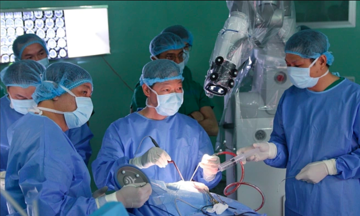On 24/7, Dr. Nguyen Quang Bay, Head of the Endocrinology - Diabetes Department at Bach Mai Hospital, reported a case of a 19-year-old woman who presented with muscle cramps and breathing difficulties. Initially, she was thought to have hypocalcemia, a condition characterized by low blood calcium levels, which can cause numbness, dizziness, and seizures. However, examinations and blood tests revealed normal calcium levels.
A review of her medical history showed that the symptoms were recurring. Each episode was treated with intravenous calcium injections followed by calcium supplements after discharge, yet the symptoms persisted.
Further investigation revealed the true cause to be hyperventilation, a condition where breathing becomes rapid and deeper than normal, often triggered by anxiety, panic, or overstimulation. Hyperventilation leads to excessive expulsion of carbon dioxide (CO2), causing the blood to become alkaline (increased pH). This can result in cerebral vasoconstriction, triggering neurological symptoms such as dizziness and confusion.
The increased blood alkalinity also reduces free calcium levels, often accompanied by a temporary decrease in potassium and magnesium. This mimics the symptoms of hypocalcemia, exacerbating numbness and muscle cramps. After the hyperventilation subsided, Dr. Bay conducted a clinical examination to determine the underlying cause and provided psychological counseling to prevent recurrence.
Such cases are not uncommon. Dr. Bay sees two to three similar patients each month, mostly young women, who experience persistent breathing difficulties and muscle cramps despite receiving calcium injections and medication.
Dr. Bay explained that many hyperventilation patients experience symptom relief after calcium injections, leading them to believe they have hypocalcemia. However, this improvement is primarily due to the calming effect of the treatment, reducing panic and slowing breathing.
If someone experiences these symptoms at home or in public, the recommended course of action is to calm the individual, encourage slow breathing, or have them cup their hands over their nose and mouth (or wear a mask) to reduce CO2 loss.
 |
Illustration of hand cramps. Photo: Provided by the doctor |
Hyperventilation, characterized by rapid and deep breathing, presents a range of symptoms including shortness of breath, dizziness, tingling sensations, fatigue, chest pain, and numbness or tingling in the extremities.
According to scientists, the most common cause of hyperventilation is the body's response to anxiety or fear, leading to excessive breathing. Approximately 50% of patients with panic disorder report experiencing hyperventilation symptoms. Conversely, 25% of those with hyperventilation syndrome also exhibit signs of panic disorder.
Most individuals are unaware of their hyperventilation until the shortness of breath and other symptoms become more frequent, making it difficult to manage anxiety effectively.
Preventive measures include learning breathing and relaxation techniques such as meditation, tai chi, yoga, or qigong. Regular exercise (walking, jogging, cycling) and developing a calm demeanor in all situations are also crucial, both for those who have not yet experienced symptoms and those who have.
Thuy Quynh












